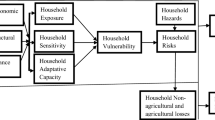Abstract
Based on a sample survey collected from randomly selected farmers inhabiting the Jamuna floodplain of Bangladesh, this study deals with the perception of and agricultural adjustments to both normal and abnormal floods. The study found that the respondents' perception of flood is conditioned by the key role played by floods in their lives. The study further observed that the respondents successfully cope with the normal floods. In cases of abnormal floods, they practiced several adjustments to reduce damages.
Similar content being viewed by others
References
Bangladesh Bureau of Statistics (1978).The Year Book of Agriculture Statistics of Bangladesh, 1976–77. Ministry of Planning, Dacca.
Harding, D. M., and Parker, D. J. (1974). Flood hazard of Shrewsbury, United Kingdom. In White, G. F. (ed.),Natural Hazards—Local, National, Global. Oxford University Press, New York.
Islam, M. A. (1980). Agricultural adjustments to flooding in Bangladesh: A preliminary report.National Geographical Journal of India 26: 50–59.
Islam, M. A. (1981). Bangladesh. In Rahman, M. (ed.),Agrarian egalitarianism. Kendall/Hunt, Dubuque, Iowa.
Islam, M. A., and Khan, A. A. M. (1974). Need for comprehensive flood damage reduction planning in Bangladesh. A paper presented at the International Physics Symposium, Dacca.
Kates, R. W. (1962). Hazard and choice perception in flood plain management. University of Chicago, Department of Geography, Research Paper No. 78.
Kates, R. W. (1963). Perceptual regions and regional perception in flood plain management.Papers and Proceedings of Regional Science Association 11: 217–227.
Kates, R. W. (1970). Natural hazard in human ecological perspective: Hypotheses and models. University of Toronto, Department of Geography, Natural Hazards Research Working Paper No. 14.
Parker, D. J., and Harding, D. M. (1979). Natural hazard evaluation, perception and adjustment.Geography 64: 307–316.
Payne, R. J., and Pigram, J. J. (1981). Changing evaluations of flood plain hazard. The Hunter River Valley, Australia.Environment and Behavior 13: 461–480.
Preston, V.et al. (1983). Adjustment to natural and technological hazards—a study of an urban residential community.Environment and Behavior 15: 143–164.
Ralph, K. A. (1975). Perception and adjustment to flood in the Meghna flood plain. Unpublished M. A. thesis, Department of Geography, University of Hawaii.
Sim, J. H., and Baumann, D. D. (1983). Educational programs and human response to natural hazards.Environment and Behavior 15: 165–189.
White, G. F. (1945). Human adjustment to flood. University of Chicago, Department of Geography, Research Paper No. 29.
White, G. F. (1961). Papers on flood problems. University of Chicago, Department of Geography, Research Paper No. 70.
White, G. F. (1964). Choice of adjustment to floods. University of Chicago, Department of Geography, Research Paper No. 93.
White, G. F. (1974).National Hazards-Local, National, Global. Oxford University Press, New York.
Author information
Authors and Affiliations
Rights and permissions
About this article
Cite this article
Paul, B.K. Perception of and agricultural adjustment to floods in Jamuna floodplain, Bangladesh. Hum Ecol 12, 3–19 (1984). https://doi.org/10.1007/BF01531281
Issue Date:
DOI: https://doi.org/10.1007/BF01531281




